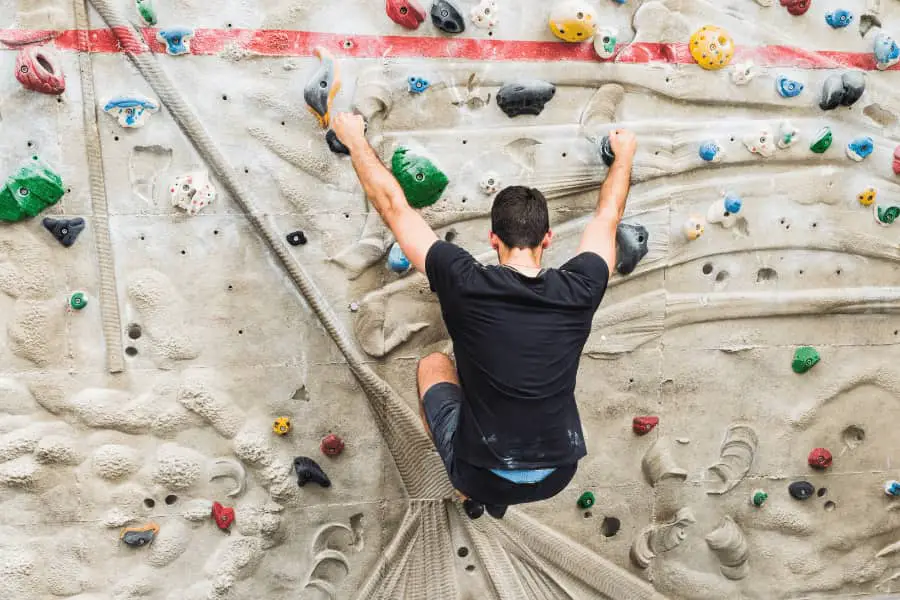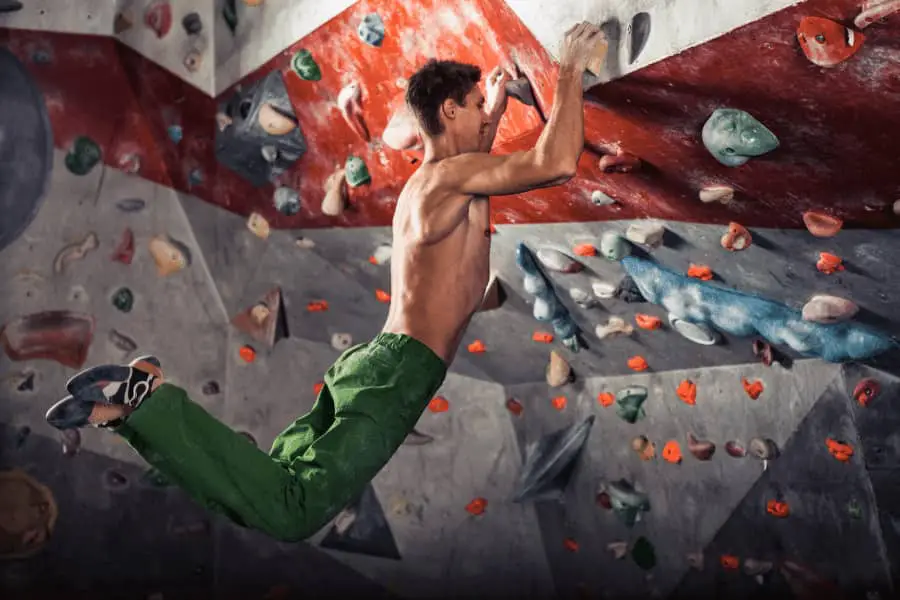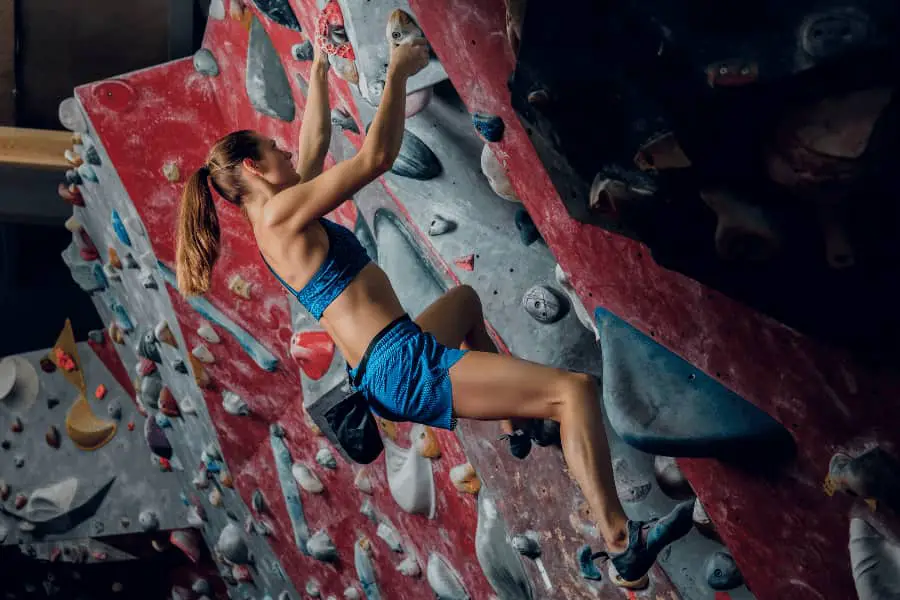
When I first started climbing I had no idea what a dyno was. After seeing someone successfully pull it off for the first time, I knew I had to try it! The only problem? I was terrible and didn’t even come remotely close to the hold. After hours of research, I was finally able to pull together the best way to get better at dynos.
To get better at dynos, you should practice correct dyno technique by crouching low, aiming at your target, jumping with your legs, and grabbing strong. Practice these techniques by starting on easier dynos and gradually increase the difficulty. Train jumping ability and grip strength to improve dyno ability.
Being able to combine all of these techniques into a single movement will make you the best at dynos you can be. However, if you are still coming up short after practicing these, there are specific training methods to improve your dyno ability.
If you are interested in seeing what the current prices are for the most popular rock climbing training aids, you can find them on Amazon by clicking here. Using the Amazon affiliate link above and/or other links in the article helps support this website.
Most Important Techniques To Master For Dynos
The first step in the process of improving your dyno ability is to master the technique. This is by far the most important step for executing dynos at a high level. It doesn’t matter how high you can jump or how much finger strength you have if you don’t have the right technique.
- Push with your legs rather than pulling with your arms. You will be able to generate more force with your legs than you can muster with pulling with your arms. This will allow you to jump higher and reach further holds.
- Get low when you are preparing to jump. Crouching low on your foot hold(s) and exploding up will allow you to activate more of your leg muscles. Activating a larger amount of your leg muscles will increase your jumping ability ten-fold.
- Jump in/straight up on the wall. When first attempting a dyno, you will most likely feel like you are moving away from the wall. To counteract this, actively focus on jumping straight up. This can feel like you are jumping towards the wall in the beginning.
- Use your hands/arms to help direct your jump. By pulling with you arms, you are able to help direction yourself towards your intended target. This will help you stay close to the wall when jumping. Note, this is not meant to generate power, just help control where you are heading.
- Aim and focus on your target. Maintaining eye contact with the hold you are jumping to will be key to being able to grasp it once there. Staring at the hold all the way through the movement will help your body determine how much strength to use when jumping. It also will help you better control where you are jumping to. Always keep your eyes on the target.
- Squeeze tighter than you normally would when completing a static movement. Grabbing onto a hold when you are flying through the air is a lot more difficult than statically grabbing onto it. You will have to apply more grip force to be able to control your momentum and stay latched to the hold.
This can be a lot to master in the beginning. All of this is happening in a fraction of a second. The best way to improve at dynos is to practice these techniques.
The Best Way To Practice Dynos

Now that you know the correct techniques, it is time to put them to use and practice them. I think the best way to practice these is to create your own dyno problem at an indoor climbing gym. Starting very easy and working your way up will build confidence and allow you to improve quickly.
To start, pick two solid foot holds at relatively the same height and a jug that is straight above them and just slightly higher than your static reach to start. Then practice jumping to this hold while focusing on the techniques discussed above. This should be very easy for you to accomplish and is meant only as a way to focus on form.
After completing that a few times, pick a top hold higher up that the previous jug and practice jumping to this. For beginners I recommend keeping that top hold as a jug because your grip strength will not be fully developed yet. For more experienced climbers, pick a solid hold that is not too easy or too hard for you to hang from for 10 seconds. Be sure to keep technique as the main focus when practicing this movement.
Once you are comfortable that you have mastered the basics, you should increase the difficulty of your dynos. A few ways to increase the difficulty of dynos:
- Use smaller footholds
- Pick wider spaced footholds
- Pick offsetting foot holds (one higher than the other)
- Use harder top holds to grab on to
- Increase the height of the top hold
- Pick holds off to one side rather than straight up
Practicing dynos at gradually harder levels is the best way to improve your dyno ability. To speed up your improvement process, you can train for dynos specifically. See the section below
The Best Exercises To Train Dynos
Certain exercises can be performed to help train dynos specifically. These training exercise will not only improve your dyno ability but will help improve your overall climbing ability as well.
Besides having the right technique, your ability to dyno boils down to two things:
- How high you can jump. Jumping ability will determine how much force you can generate with your legs and therefore will decide the maximum distance of holds you can reach. This is trained by increasing your leg strength.
- How strong your grip strength is. Grip strength will determine what holds you can jump to and stick. It doesn’t matter how high/far you jump if you can’t grab onto the hold. This is trained by increasing your forearm and finger strength.
You can either train these abilities using climbing specific exercises or use cross-training techniques such as weight lifting or playing other sports.
Climbing Specific Exercises

These exercises will specifically train your dyno weaknesses and can be performed in most climbing gyms.
Improving Your Jumping Ability
- Practice climbing with minimal hand involvement. Focusing on using your legs to push yourself up the wall will help develop the strength needed to push off the foot holds on a dyno. It also will help you develop a better mind-muscle connection. Increase difficulty by pulling less with your hands.
- Use higher foot holds than normal. Using higher foot holds will force your legs to work harder when climbing. This will help you generate pushing power in your legs. Increase difficulty by using higher foot holds.
- Practice dynos only using one leg. This will target that leg’s jumping power specifically. Be sure to alternate legs when practicing. Increase difficulty by increasing the distance to the hand hold.
Improving Your Grip Strength
- Climb crimp-heavy routes. This method is the best for newer climbers. Climbing routes with a lot of crimps will cause your forearms to work on overdrive. This will build the necessary grip strength needed for catching harder dynos than those to jugs. Increase difficulty by using smaller crimps.
- Practice on a hang board. This method is the best for slightly more experienced climbers. This will help develop grip and finger strength quicker than having to climb crimp-heavy routes over and over again. Increase difficulty by increasing hang time or decreasing hold width.
- Use a campus board. This method will be for the most experienced climbers as it requires the most strength to do properly. Many climbers have gotten injured when using campus boards so be sure to use proper form. Increase your reaching distance to increase difficulty.
Cross-Training Exercises
These exercises are great for climbers that have access to weights or a gym. Although not necessary, these exercises will dramatically increase your dyno ability.
Improving Your Jumping Ability
- Box jumps. These will be the most functional movements that will transfer over the best for jumping ability on the wall. Box jumps allow you to practice the actual jumping form itself and recruit more muscle groups to work together. On top of this, it will build muscle in your legs allowing you to jump higher. Increase box height ot increase difficulty.
- Squats. These are the best exercises to build leg strength. Squats have been heralded as the king of weight lifting exercises for good reason. These are the ultimate exercise for building overall muscle in the glutes, quads and hamstrings. Increase weight to increase difficulty.
- Jumping rope. Like box jumps, jumping rope will help practice the movement of jumping itself. Unlike squats, jumping rope mainly focuses on building muscle and strength in the calf muscles. Increase jumping time to increase difficulty.
Improving Your Grip Strength
- Grip machines. As the name implies, these will target your grip strength like nothing else. The only drawback is that you will most likely have to purchase one as these are very uncommon to be in gyms. Increase weight to increase difficulty.
- Wrist rolls. If you do not wish to purchase a grip machine, you can perform wrist rolls to target your forearms. although wrist rolls don’t directly target your grip strength, they target the muscles that determine grip strength. Increase difficulty by increasing weight.
- Farmer’s carry. This exercise is the most indirect way to train grip strength of the ones listed above. The farmers carry will not only train your forearms but will target your traps as well (upper back). If your traps are weak compared to your grip strength, this exercise will not be much help to you. Increase difficulty by increasing weight.
The bottom line? Dynos are incredibly fun to pull off but require a lot of technique. To get better at dynos, practice training your technique on easier holds and increase the difficulty over time. Specific exercises such as box jumps and hang boarding can be used to target dyno specific muscles.
